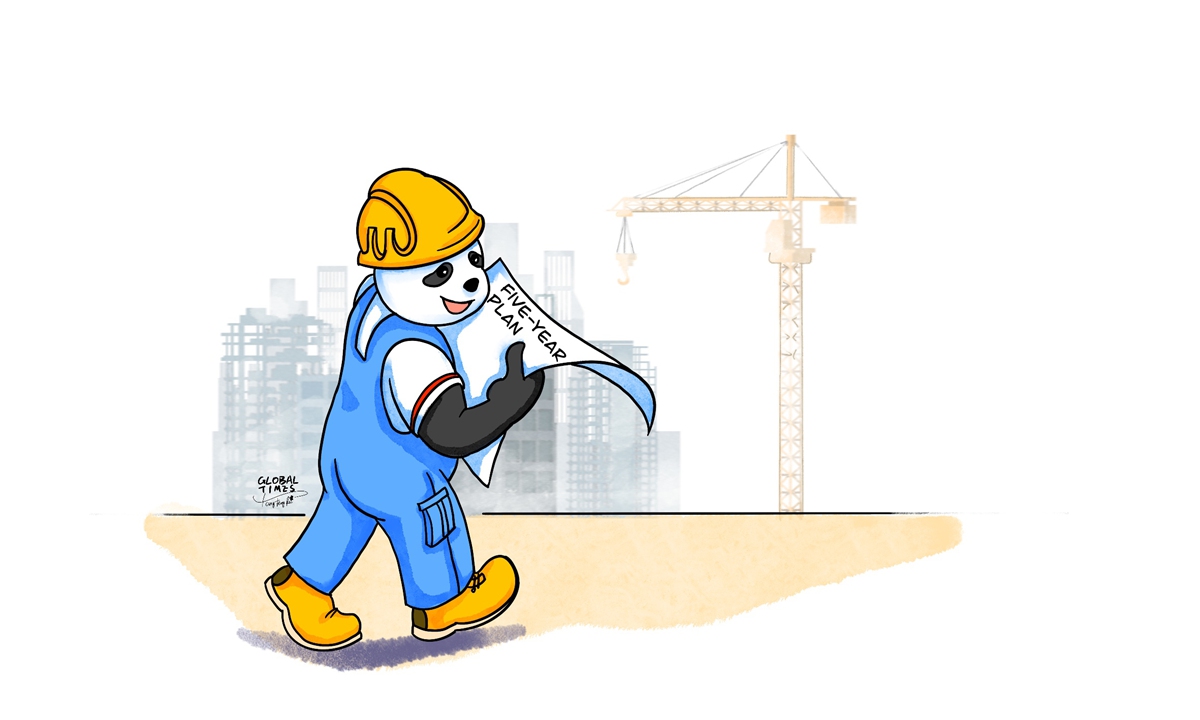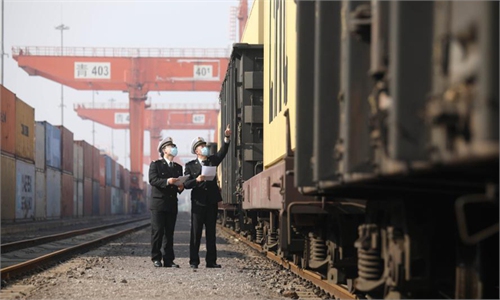China offers certainty during uncertain times

Five-Year Plan. Illustration: Tang Tengfei/GT
Picture this. Someone tells you that if you invest 1 yuan ($0.15), you will harvest 100 trillion yuan after 100 years. This means that the yearly return is 38 percent, which is twice that of US investor and business tycoon Warren Buffet over the past 50 years. Given this scenario, would you invest? No one would have faith in this long-lasting and stable rate of return. But the Communist Party of China has done it.Some people once compared the establishment of the Party 100 years ago to a corporate entrepreneurship, compared the founding of the People's Republic of China in 1949 to the company's listing in the market, compared the reform and opening-up in 1978 to its internationalization, and compared China's GDP in 2020 to its market value. So will investors pay attention to the company with a market value of 100 trillion yuan when it announces its plan for the next 15 years? Investors of foresight will be optimistic about the stock and hold it for a long time.
This is why I recommend readers to read "The Outline of the 14th Five-Year Plan (2021-25) for National Economic and Social Development and the Long-Range Objectives through the Year 2035." This records in detail the goals, policies and paths of the first five years of China's journey toward the second centenary goal and in 15 years.
There are at least three very important keywords to keep in mind here.
The first is high quality. The outline did not put forward specific economic development goals for the next five years, but instead proposed to keep the economy within a reasonable range and put forward specific goals according to each year's situation. China has pragmatic plans for indicators that represent the country's high-quality development. These include increasing the percentage of permanent urban residents to a total population from 60.6 percent to 65 percent. They also entail increasing research and development expenditures by more than 7 percent annually, reducing energy consumption per unit of GDP by 13.5 percent, and raising the average life expectancy by one year.
This shows that China's development no longer pursues excessive speed, but quality. And China is taking concrete measures for this.
The second is risk proof. Risks in the domestic and international environment are clearly addressed in the outline. The world has entered a period of turbulence and change, but the problem of unbalanced and inadequate domestic development remains acute. The possibility of risks is clear: epidemic, social, financial, supply chain, environmental pollution and the risk of backsliding into poverty again.
This is why the outline calls for greater risk awareness, preparation for worst-case scenarios, and improved systems and mechanisms for preventing and defusing major risks. This reflects the prudence, moderation and strategic confidence of Chinese policymakers.
The third is pragmatic reform. The outline has made a fairly detailed plan in 17 aspects including innovation-driven development, modern industrial system, strong domestic market, accelerating the development of digitalization and rural revitalization. Finally, it also set up the planning security system. The outline didn't pronounce lofty and flowery ideals, but instead emphasizes details, steps and a realistic spirit.
At a time when many countries are uncertain about their policies for the next five or 15 days, China hopes to show the certainty of the next five or 15 years with the most feasible plans. This can provide the world with relatively stable expectations and a measurable development orientation.
If we look into all the national development plans since the first five-year plan was made in 1952, we can easily find that China's five-year plans are the most sustainable and achievable national policy plans in the world or even the entire human history. People should read the new outline.
Because the West lacks the in-depth research into China's five-year plans, it usually breeds two extreme sentiments toward China. The first is its fear of the so-called threat from China's development. The second is the tendency to curse China with the so-called China collapse theory. Facts have proved that some Western observers are wrong. The new starting point of predicting China can be achieved by reading the new outline.
US sociologist Immanuel Wallerstein wrote in his 1999 book The End of the World as We Know It, what we know in the 21st century should be more open than what we knew during the 20th century. If this logic works, the whole world, especially the West, should evaluate whether or not China, which has developed in high quality, poses opportunities or challenges over the next five to 15 years? Should the world embrace or reject China? Should the world cooperate with or give up cooperating with China? This will test the West's strategic wisdom toward China.
The author is professor and executive dean of Chongyang Institute for Financial Studies at Renmin University of China. opinion@globaltimes.com.cn




